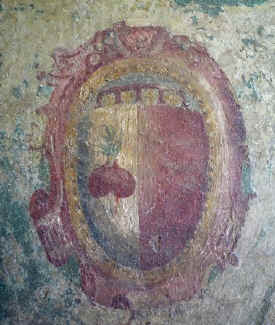|
The municipality of Certaldo covers 75 sq km of the hills that form the watershed between the
Val d'Elsa and the Val di Pesa. It originated as a feudal castle and then became a comune with a Podesta and Vicariate Seat until 1774 when it became a municipality under the
Leopoldine reforms.
|

Coat of Arms
of Certaldo |
The Certaldo onion
Mediaeval Certaldo's Coat of Arms (stemma) was a shield including a purple onion on a white background. This symbol can still be seen in a fresco on the wall of the Palazzo Pretorio. The town motto is a metaphoric encomium to the onion that can be loosely translated as “by nature I am both strong and sweet, and I please those at work and those at rest”.
The lowly onion was removed from the coat of arms in 1633, but reinstated 1867.
There are two varieties of Certaldo
onion,
the Statina, which is round in shape and purplish in color with succulent
flesh, and the bright red and pungent Vernina which is harvested from the end of August through the winter months.
Boccaccio mentions
the Certaldo onion in Book VI of the Decameron.
Heraldic description of the stemma of Certaldo
Partito: al primo, d'argento alla cipolla sradicata col bulbo, le radici
e le foglie al naturale; al secondo, di rosso. |
Certaldo is one of the major centres of the Val d'Elsa and probably came into
being as an inhabited nucleus around the 10 C. It was a feudal castle of the Alberti Counts and the first document which mentions it
explicitly is a certificate by Federico Barbarossa dating from 1164. In exchange for his
freedom, Count Alberto degli Alberti, who had been imprisoned by the Florentines after the destruction of Pogna Castle,
destroyed the tower of Certaldo in 1184 and ceded the ownership of the castle to
Florence, reserving for himself only the tributes and alodial assets. But the definitive collapse for the Alberti Counts came soon after with the fall of
Semifonte
(1202). Certaldo also became incorporated in the county of Florence, becoming Seat of a Podesta and in 1415 Firenze made it Vicariate Capital of the Val di Pesa and of part of the Val d'Elsa and Valdarno Inferiore
(1415). From 1400, the castle was enlarged to match its importance. It was surrounded with
stone walls and the imposing Palazzo Pretorio was constructed where in ancient times the residence of the Alberti Counts was
situated.
In 1479, Certaldo was sacked by the soldiers of the King of Naples
and Pope Sextus IV, allied
with Sienna, but
during the last Florentine republic and the Grand Duchy of Tuscany it grew again,
especially in the lower section called the "village" and in ancient times the Castle's market.
In 1784 Pietro Leopoldo suppressed the Vicariate, uniting it to that of
San
Miniato.
In consequence of the decline which then followed, the municipality managed to raise itself again only in the second half of the 1800s. During the second world war, between 1943 and 1944, it suffered losses and severe destruction. Postwar Certaldo rapidly recovered becoming
a busy agricultural and industrial centre.
|
